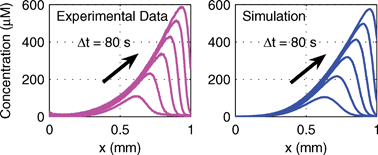Temperature gradient focusing (TGF) is a new and promising equilibrium gradient focusing method which can provide high concentration factors for improved detection limits in combination with high-resolution separation. In this technique, temperature-dependent buffer chemistry is employed to generate a gradient in the analyte electrophoretic velocity. By the application of a convective counter-flow, a zero-velocity point is created within a microchannel, at which location the ionic analytes accumulate or focus. In general, the analyte concentration is small when compared with buffer ion concentrations, such that the focusing mechanism works in the ideal, linearized regime. However, this presumption may at times be violated due to significant sample concentration growth or the use of a low-concentration buffer. Under these situations the sample concentration becomes non-negligible and can induce strong nonlinear interactions with buffer ions, which eventually lead to peak shifting and distortion, and the loss of detectability and resolution. In this work we combine theory, simulation, and experimental data to present a detailed study on nonlinear sample-buffer interactions in TGF. One of the key results is the derivation of a generalized Kohlrausch regulating function (KRF) that is valid for systems in which the electrophoretic mobilities are not constant but vary spatially. This generalized KRF greatly facilitates analysis, allowing reduction of the problem to a single equation describing sample concentration evolution, and is applicable to other problems with heterogeneous electrophoretic mobilities. Using this sample evolution equation we have derived an understanding of the nonlinear peak deformation phenomenon observed experimentally in TGF. We have used numerical simulations to validate our theory and to quantitatively predict TGF. Our simulation results demonstrate excellent agreement with experimental data, and also indicate that the proper inclusion of Taylor dispersion is important for the accurate modeling of TGF. This work is an important first step towards the understanding and prediction of the more complex, nonlinear, and multi-species interactions which often occur in on-chip electrophoretic assays such as TGF.


 Please wait while we load your content...
Please wait while we load your content...